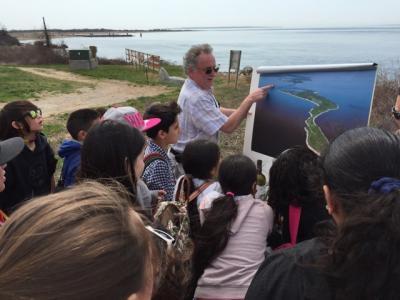The Fight for Plum Island’s Future

Seeking to stop the federal government from auctioning off Plum Island, the 840-acre island that lies off Orient Point on the North Fork, eight organizations and individuals have sued the Department of Homeland Security, which operates the animal disease center there, and the General Services Administration, which was directed by Congress in 2008 to sell the island to the highest bidder.
The plaintiffs alleged in a July 7 complaint that the government is violating its own laws, including the National Environmental Protection Act and Endangered Species Act, by pursuing the public sale of the island. They also say the agencies have not done a good enough job on a required environmental impact statement.
Nearly every town, state, and federal official on the East End has come out against the sale, including Representative Lee Zeldin, in whose district the island lies, and Senators Chuck Schumer and Kirsten Gillibrand. Mr. Zeldin was able recently to get two measures passed in the House to stop the sale and has called for the Senate to adopt similar legislation.
“I am supportive of the local groups’ efforts and any efforts to prevent the sale of Plum Island,” Mr. Zeldin said in an email. “I will continue doing all that I can to ensure that we can pursue a better direction for Plum Island that would allow for continued research, public access, and permanent preservation of the island.”
While Mr. Zeldin’s House initiatives received bipartisan unanimous support, it is unclear who or what organizations may be supporting the sale.
Others filing suit are Peconic Baykeeper, Soundkeeper Inc., the Connecticut Fund for the Environment, and Save the Sound, along with John Turner, a birder and environmental advocate, John Potter, the president of CT/RI Coastal Flyfishers, and Ruth Ann Bramson, a historian and co-author of “A World Unto Itself: The Remarkable History of Plum Island, New York.” Morrison & Foerster, a law firm based in New York and San Francisco, is representing them without charge.
“The government holds the wildlife and natural resources in public trust for the people, not the private gain of individual developers,” Roger Reynolds, legal director of the Connecticut Fund for the Environment and Save the Sound, said in a statement. “We are asking the court to halt any sale of Plum Island and to order the agencies to fully consider conserving the resources on the undeveloped portion of the island that does not support the research facility operations, whether through a conservation sale or outright protection.”
“The law says you have to define the level of potential environmental harm for what’s going to happen to that island when you sell it,” Bob DeLuca, president of the Group for the East End, one of the plaintiffs, said. “They put most of that review off until some later time,” he said. “The challenge is to overturn the federal decision to proceed until such time that those questions are answered.”
Because of the security restrictions associated with animal disease research, the island has remained off-limits to the general public and largely untouched by development. The plaintiffs say the majority of the island has become “a de facto wildlife refuge” home to endangered species such as the roseate tern and to threatened species such as the piping plover. Harbor seals, grey seals, and endangered sea turtles are common visitors to the island and it is said to be the site of several rare plants.
When federal lawmakers directed the General Services Administration to sell Plum Island in 2008, they said it would offset the cost of building a new biological and agricultural research facility in Kansas as well as rehabilitating the island. Opponents of the sale have said the proceeds wouldn’t come close to what would be needed.
“It’s hard to find anybody with a passionate conviction to sell the island, but it got set in motion,” Mr. DeLuca said. “At this point it’s an act of Congress, so it’s not easy to find the off switch.”
Mr. DeLuca said that Plum Island is environmentally significant since it is in the Long Island Sound and Peconic estuaries and is also historically significant thanks to its lighthouse and the former Fort Terry.
“People think it’s just a laboratory, but only 10 to 15 percent is a laboratory. The rest of it is largely undisturbed. . . . Aside from perhaps Gardiner’s Island, you don’t really have any other place in our region with that many kinds of unique ecological elements all in one place.”
